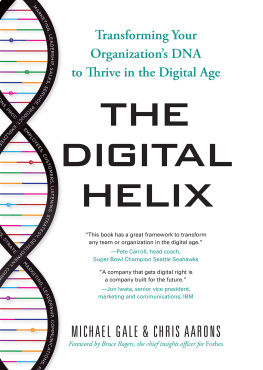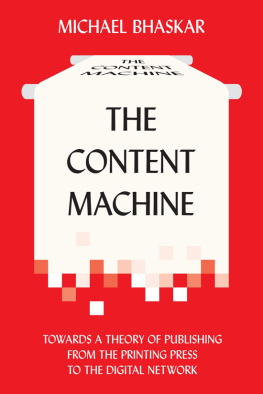All contributors to this collection maintain the copyright on their contributions to this book.
Printed in the United States of America. Published by OReilly Media, Inc, 1005 Gravenstein Highway North, Sebastopol, CA 95472. OReilly books may be purchased for educational, business, or sales promotional use. For more information, contact our corporate/institutional sales department: (800) 998-9938 or corporate@oreilly.com.
This book is available online at: http://book.pressbooks.com.
The print, ebook and web versions of this book were produced and typeset using PressBooks.com, a single-file-source book production tool that outputs EPUB, typeset PDF, and web versions of all books. For more information, visit http://pressbooks.com.
July 2012: First Edition.
While every precaution has been taken in the preparation of this book, the publisher and authors assume no responsibility for errors or omissions, or for damages resulting from the use of the information contained herein.
This ebook was produced with http://pressbooks.com.
Preface
This book is the result of a belief: that digital fundamentally alters the mechanics of publishing books. There is much talk about this shift in the publishing world a calendar filled with conferences, a blogosphere popping with opinion, and not a few op-eds and even books on this very topic, some many years old.
But we wanted to get beyond beliefs with this work, to get into the nuts and bolts of things. We wanted our contributors to be not just perceptive thinkers, but also doers, people who are building the kinds of tools and companies that will continue to shape publishing for years to come.
Indeed the idea for Book came about not so much as an idea for a book, as a way to put to real-world use a new kind of digital tool for book publishing that my small company was (and is) in the process of building: PressBooks.com. PressBooks is a simple, but powerful web-based book production tool, that produces ebooks, print books, and webbooks, all from one online source file. I thought I should be in the middle of it, testing it with a real publishing project.
So I pitched the idea for the book, first to my friend Brian OLeary, who is as seasoned about book publishing as I am naive. Brian liked it, and we agreed that the best place for the book was OReilly Media, a publishing company known for its aggressive embrace of digital innovation. Joe Wikert, Publisher at OReilly, liked it too and we spent a good number of hours talking about how to walk the walk of the changes happening in publishing as we produced this book.
Were building this book writing, editorial, copyediting, proofing, and production of the ebook (and later print) output on a new online tool, PressBooks, and learning valuable things in the process. We released the book in three parts, and OReilly experimented with staged pricing with these releases. In addition, were releasing the book for free online, and selling it as an ebook, and a print version as well.
Book: A Futurists Manifesto is as much about the process as it is about the content. A big part of that process is you, the reader because publishing does not stop once the book goes out into the wild. Maybe thats when publishing really begins. Wed love to get your feedback, thoughts and criticisms, and the best place for that feedback is the online version of this book, which can be found at: book.pressbooks.com.
Hugh McGuire.
Introduction
The ground beneath the publishing industry trembled in 2007, when Amazon released the Kindle and Apple released the iPhone. Digitalwhich had wrought havoc on the music and newspaper industrieswas finally coming to the consumer market for books. Certainly digital had been reshaping reading, and much of what we call publishing since at least the 1970s, but for the mass market, 2007 was when the general population started to consider that books might come in pixels rather than pages. In the few years since, these devices and their spawn have brought digital reading of long-form text from the realm of it might happen sometime to it is happening right now, and faster than anyone predicted. Many questions have been answered, resoundingly: Will readers read ebooks? Yes. Lots? Yes. Dedicated reading devices, or smartphones, or tablets? Doesnt matter, as long as there is cross-device accessibility. Browser reading? See previous. Shakeup in publishing? Sorta, but the sky is still overhead.
That rapid shakeupfrom print to digital buying and readinghas been massive, but its really only a transitional phase to a radically different future.
Just a Shift?
We used to live in a paper-based model: Publishers sent print books to distributors and retailers, who sold print books to readers, who took those books home or to work and read them when and where they liked.
We are now effectively replicating this model for digital: Publishers send digital files to distributors and retailers, who sell those files to readers, who download them onto various devices and read them when and where they like.
Of course much else has happened. Pricing structures have changed (the 99-cent best-seller, as well as the agency model), the barriers to entry have crumbled (Bowker estimates 2.8 million print-on-demand and self-published print books came into being in 2010, versus an estimated 270,000 traditionally published books; Smashwords currently distributes some 30,000 ebook authors and 80,000 titles), and the role of the publisher in this disintermediated world is in question (crime writer Joe Konrath claims he does much better without a traditional publisher, and Amanda Hocking sold more than a million copies of her self-published paranormal novel through Kindle, and then went on to sign a multi-book deal with St. Martins Press).
Or a Fundamental Restructuring?
But there is a greater shift afoot than just pricing and delivery mechanisms, and that is what this book aims to explore. We want to examine how digital changes the process of making a book, as well as what we do with it afterwards.
The move to digital is not just a format shift, but a fundamental restructuring of the universe of publishing. This restructuring will touch every part of a publishing enterpriseor at least most publishing enterprises. Shifting to digital formats is part one of this changing universe; part two is what happens once everything is digital. This is the big, exciting unknown.
What happens when all books are truly digital, connected, ubiquitous? Were starting to put the infrastructure in place now, so we can start doing things with books that have never before been possible.
Whats In the Book?
This book is meant to be a guidebook for the futurea collection of essays from thought leaders and practitioners about the bleeding edge of publishing. Weve organized it in three parts:
Part 1. The Setup: Approaches to the Digital Present
In this section, we explore what digital means right now for publishers, and how we need to rethink critical practical matters like design, metadata, and workflow, as well as the underlying assumptions about what a book is







